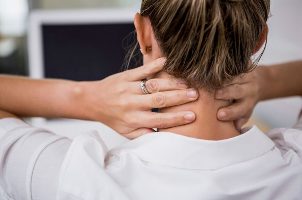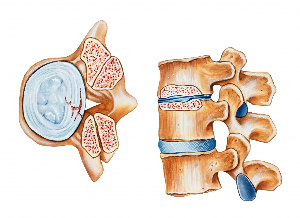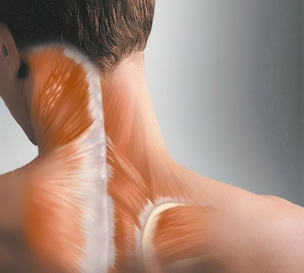Neck pain can be painful for many reasons. In most cases, in order to choose the right pain reliever, the first thing to do is determine what is causing the pain and muscle tension. Both medications and folk remedies help relieve neck pain quickly.
Neck structure
The neck contains:
- cervical spine,
- muscles,
- bundle,
- larynx,
- thyroid.
There are seven vertebrae in the cervical spine. Compared to the rest of the spine, the cervical vertebrae are not large. Like all others, they consist of the body and processes with muscles and ligaments attached.
Between the vertebrae - discs with the outer rigid part, which consists of fibrous fibers, and the inner, soft nucleus pulposus, which supplies the spine with shock absorption.
Causes of neck pain

Traumatic injury
It can be obtained when you are engaged in sports, fall upside down, in an accident or in a traffic accident. With sudden braking in the course of a rapid movement in the cervical spine, a "whiplash symptom" occurs, as a result of which sprains and muscles, compression fractures, dislocation of the neck discs with the formation of hernias are possible.
Bad posture
Prolonged work in a monotonous position, sleeping on an uncomfortable or excessively soft pillow, and prolonged static stress are predisposing factors. As a result, a bend appears, the head begins to move forward in relation to the body, the ligaments and muscles of the neck begin to experience increased tension.
Osteochondrosis of the spine
With osteochondrosis there is a violation of the trophism of the intervertebral disc with its flattening and changes in the surrounding tissue. As a result, a decrease in the payback function and the appearance of pain in the neck.
The cause of osteochondrosis can be poor diet, back injuries, increased physical activity, unfavorable environment, chronic stress, inactive lifestyle, bad habits. There is also a genetic predisposition.
With osteochondrosis, pain in the neck, shoulders, arms, dizziness and fainting occurs. Impairment of hearing, eyesight and memory. "Vertebral artery syndrome" - blinking flies in front of the eyes, tinnitus. Impaired coordination and gait fluctuations.

protrusion or herniated disc
This is the name of the protrusion of the intervertebral disc from the spine. With an inguinal hernia, the outer annulus is destroyed by shifting its central part in any direction - sideways, backwards or forwards.
The most difficult pathology is the displacement of the nucleus inward - this can lead to injury to the spinal cord. With age, osteochondrosis of the spine can join the hernia. All of the above can cause an inguinal hernia, carrying heavy bags, scoliosis, flat feet, and age-related changes in the body.
Symptoms are similar to those of osteochondrosis, in addition to instability in blood pressure, insomnia, weakness in the hands, and numbness of the fingers.
Ischemic heart disease - heart attack, angina attack
With this pathology, both radiation pain radiating to the neck and independent pain in the neck and lower jaw are possible. Usually they are combined with other signs of myocardial ischemia: fear of death, shortness of breath, sweating, nausea, and vomiting.
Benign or malignant growths
The growing tumor puts pressure on the nerve roots, causing neck pain and other symptoms of spinal cord compression. Benign tumors (neuroma, hemangioma) usually have the correct rounded shape and a clear edge.
Cervical pain is mild. Basically, the compression of tissues from a growing tumor is uncomfortable. Malignant diseases (lymphogranulomatosis, sarcoma, thyroid cancer) have practically no limits and metastasize into neighboring tissues.
The destruction of the tissue causes pain and a deterioration in the general condition. Neck pain in the front occurs with tumors of the oral cavity, larynx and thyroid gland. Along with pain, there are difficulty swallowing, impaired phonation, swelling of the face and neck.
With a bone tumor, the spinal cord and nerve roots are often damaged, which leads to paralysis.
Neck myositis
Appears after hypothermia or prolonged muscle strain. It is characterized by the appearance of acute pain when moving. Pain can occur both with inflammation of the superficial muscles (sternocleidomastoid) and deep around the spine involved in neck movements.
Palpation shows muscle hypertension and sometimes hard, painful nodules. Chronic myositis leads to a disruption of the blood supply, trophism and the replacement of muscle cells (myocytes) with connective tissue.
This causes pain and weakness in the muscles of the neck, a violation of the symmetrical work of the muscles on the sides of the spine with the appearance of torticollis: the inability to keep the head strictly in an upright position.
Other diseases that cause neck pain
Spondylolisthesis: One vertebra "slips" with an intervertebral disc from the other.
Bechterew's disease - ankylosing spondylarthritis.
meningitis. Hypertonicity and stiffness of the neck muscles cause severe back pain in the neck when attempting to tilt the head.
How to relieve neck pain with medication
First, you need to identify the possible cause of your neck pain. In any case, you limit your mobility. In the event of trauma, ensure that the damaged section is immobilized and take the patient to the trauma center.
If you have a history of ischemic disease, call an ambulance and use sublingual vasodilators to stop the pain. Try to calm the patient down.
If there is a possibility of meningitis - if there has been contact with a sick person - also call an ambulance. But in any case - to stop the pain yourself. Do not heat the sore spot!
A good effect is noted when taking nonsteroidal anti-inflammatory drugs - acetic acid. They also reduce morning stiffness and are anti-platelet - they prevent red blood cells from sticking together.
Propionic acid derivatives also contribute to pain relief. They are not very toxic, are easily absorbed from the gastrointestinal tract and have a sufficient range of effects.
Option to replace tablet drugs - suppositories.
When the neck, shoulders and arms hurt
Gels are useful for treating shoulder and arm pain.
Relieves neck pain and tension from muscle cramps

In order to alleviate the existing muscle cramp along with analgesics, it is good to give muscle relaxants.
External remedies for severe cervical pain
To relieve neck pain in cervical osteochondrosis or other diseases, local therapy is not superfluous - the use of various rubs and compresses. After rubbing it, wrap your neck with a warm handkerchief and avoid water.
How to relieve neck pain with folk remedies
Attach a whole kale or burdock leaf to your neck.
Mix 50 ml of horseradish root juice with the same amount of vodka. Rub or apply compresses.
Use kerosene, which has previously been deposited and passed through activated charcoal, as a heating medium for grinding.
Make a honey cake out of honey and flour and apply it to a sore area.
Use whole honey for grinding, you can - half with aloe juice.
A mixture obtained by mixing equal parts of radish juice, honey and vodka and used for grinding.
Use a chamomile or marigold infusion for compresses on the neck. Grind horseradish root, add a little water, apply to the sore area.
Add paprika, ammonia, or honey to the medicinal bile. Use for compresses.





































